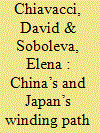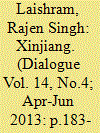| Srl | Item |
| 1 |
ID:
190964


|
|
|
|
|
| Summary/Abstract |
In the early 1980s, the People’s Republic of China (PRC) and Japan joined the international refugee regime. This timing similarity is puzzling due to the stark differences between the PRC as a communist and authoritarian state versus Japan as a prime example of capitalist development and democratization. Moreover, although both signed the 1951 Refugee Convention and the 1967 Refugee Protocol without major reservations, neither of them has fully implemented these treaties. Discussions regarding the PRC’s and Japan’s engagement with the international refugee regime tend to start with the beginning of the Indochina refugee crisis in 1975. However, this article shows that the early decades of their interaction with the international refugee regime are of crucial importance for a full understanding of the timing and form of accession to the international refugee regime. Although the Southeast Asian refugee crisis played an important role as a trigger, it was the changing character of the international refugee regime and the transformations of state identity in both countries that set the ground for the signing of the refugee-related conventions.
|
|
|
|
|
|
|
|
|
|
|
|
|
|
|
|
| 2 |
ID:
122451


|
|
|
|
|
| Publication |
2013.
|
| Summary/Abstract |
The disquiet in Xinjiang province of the People's Republic of China
(PRC) is becoming acute. A series of events in the recent past attest to
the gravity of the situation and are suggestive of the tenuous Chinese
control in this 'new' frontier province of China. The trajectories of
contest in Xinjiang or Sinkiang appear to be inherent in the frontier
areas of any vast country wherein race, religion, culture and historical
memories impinge. The frontier area, Xinjiang, is a zone "in which all
possible boundaries of geography, race and culture cross and overlap
to form a broad transitional area of great complexity".
1
Xinjiang has
been continually remote from the power centre, with visible patterns of
'incomplete authority' or 'legitimacy crisis' from the central authority.
In addition, the depiction that inhabitants of the frontier areas are
"ethnically different from each empire's ruling elite or majority and
that there was little identification with the central regimes"
2
has
relevance in the case of Xinjiang. An avid writer notes, the history of
Xinjiang is a story of many interactions¯people, cultures and politics¯not
of a single nation but of many overlapping political and social groupings
before the racial or the national categorisation of 'Turkic,' 'Uyghur'
and 'Chinese', which became evident in the twentieth century.
3
|
|
|
|
|
|
|
|
|
|
|
|
|
|
|
|